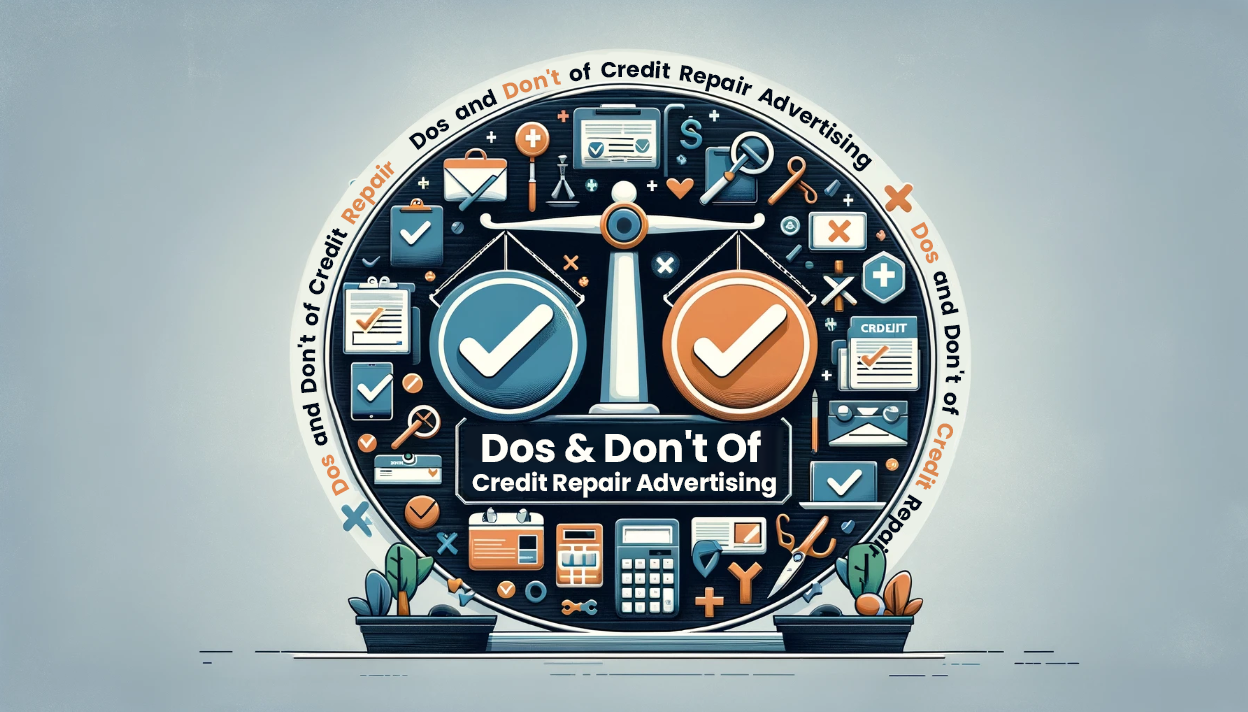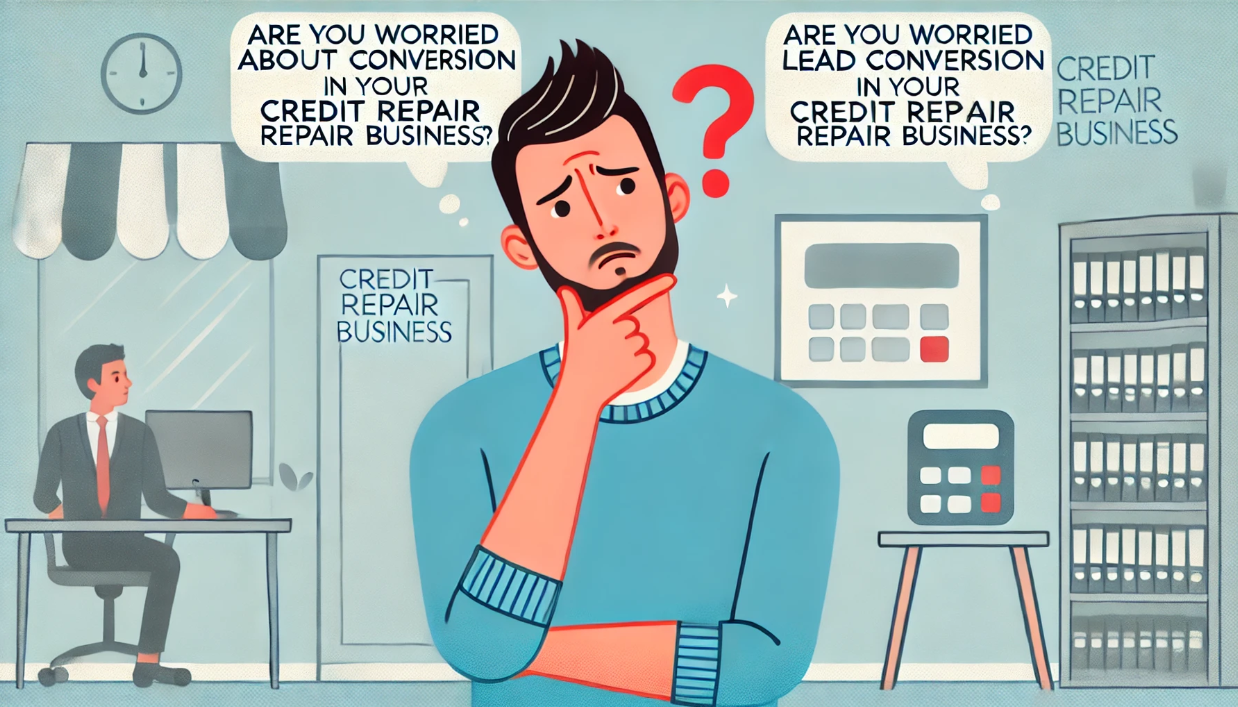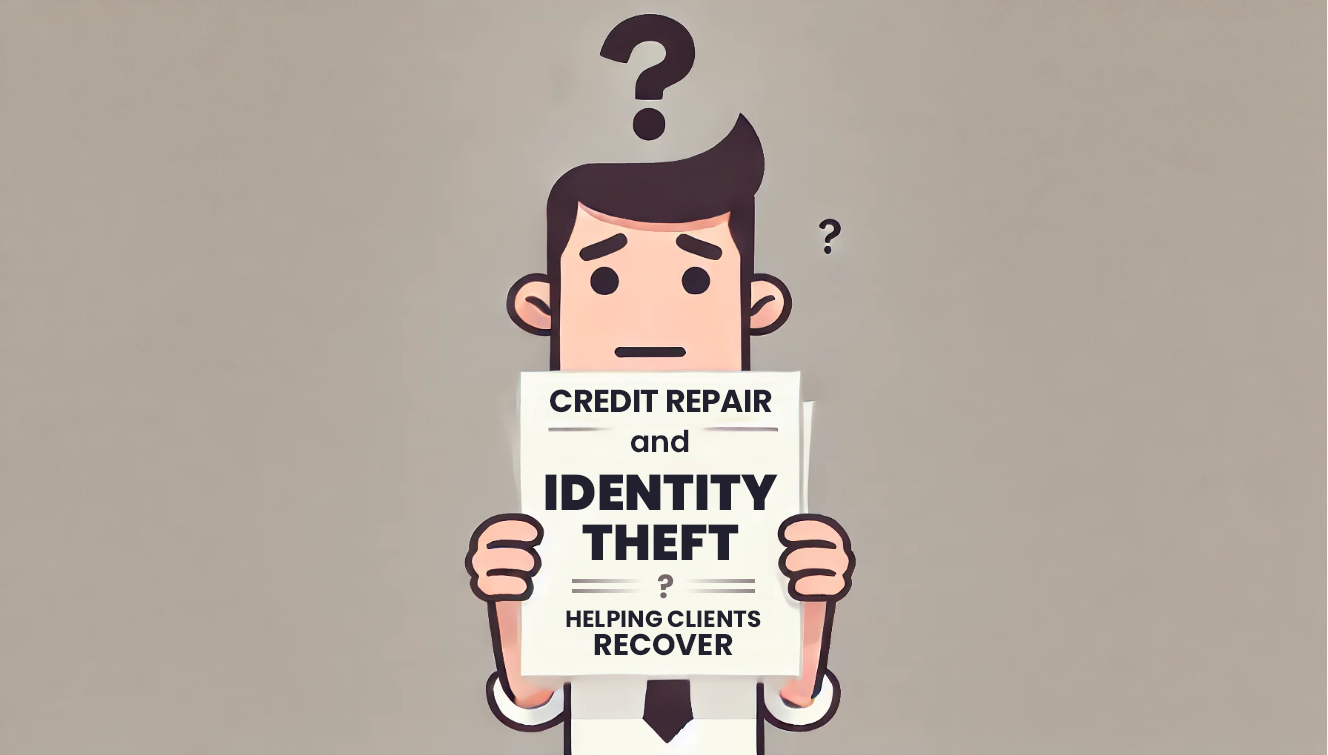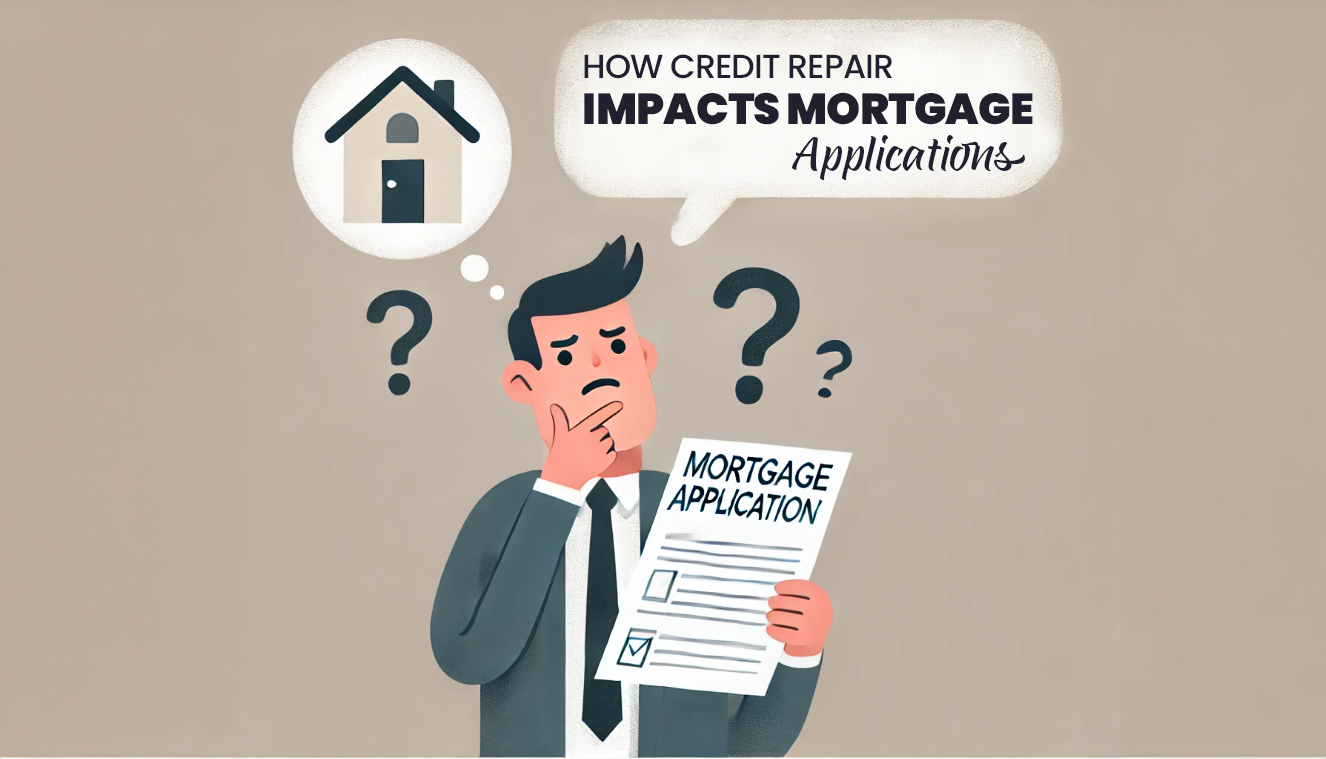Dos and Don’ts of Credit Repair Advertising and Marketing
Do you know the dos and don’ts of credit repair advertising? In the rapidly evolving credit repair industry, staying ahead in marketing and advertising strategies is not just about being visible—it’s about being smart and compliant. For credit repair businesses, navigating the intricate web of consumer trust, legal compliance, and effective outreach is paramount.
This blog post delves into the essential dos and don’ts of credit repair advertising and marketing, offering a roadmap for businesses to communicate their value while adhering to industry standards.
Top 5 Do’s of Credit Repair Advertising and Marketing
The way a credit repair business presents itself, communicates its services, and engages with potential clients can significantly impact its ability to build trust and, by extension, its market success. Transparent messaging, adherence to legal obligations, client testimonials, educational outreach, and savvy SEO strategies form the cornerstone of effective and ethical marketing in this industry.
1. Use Transparent Messaging
Transparency in messaging means being honest and clear about what your services can and cannot do for your clients. It’s about avoiding the allure of making grandiose promises that can’t be kept and instead focusing on realistic outcomes and processes involved in credit repair. This approach not only sets correct expectations but also aligns with ethical advertising standards.
Implementing Transparency
- Tips for Creating Clear and Honest Ad Copy: Start with clarity. Use straightforward language that your audience can easily understand. Avoid technical jargon or fine print that might obscure the true nature of your services. Next, be honest about the potential outcomes of your services, including any risks or uncertainties. Incorporate disclaimers where necessary to further clarify the scope and limitations of your services.
- Examples of Transparent Messaging in Marketing Materials: An effective example could be a webpage dedicated to explaining the credit repair process, highlighting both what can be achieved (e.g., disputing inaccuracies on credit reports) and what cannot be guaranteed (e.g., specific credit score increases within a definite timeframe).
Benefits of Transparency
- Building Long-term Client Relationships: Clear and honest communication fosters trust from the outset. Clients who are well-informed about what to expect and then see those expectations met are more likely to remain engaged with your services over time.
- Legal and Reputational Benefits: Transparency is not just morally right; it’s legally prudent. Adhering to truth-in-advertising laws helps avoid regulatory scrutiny and potential legal challenges. Moreover, a reputation for honesty can become a significant competitive advantage in the credit repair industry.
2. Know Your Legal Obligations
Overview of CROA and State Regulations
The Credit Repair Organizations Act (CROA) provides a federal framework designed to protect consumers from deceptive practices in credit repair. It mandates certain disclosures and prohibits misleading representations. Additionally, various states have enacted their own laws that may impose additional requirements or prohibitions on credit repair services.
Compliance Strategies
- Staying Updated on Legal Requirements: Regular engagement with legal counsel, subscription to industry newsletters, and participation in credit repair associations can help stay informed on current and evolving legal standards.
- Tools and Resources for Compliance: Utilizing legal advisories, compliant credit repair software, and regulatory compliance checklists can help ensure that all marketing materials and practices adhere to both federal and state laws.
Avoiding Common Legal Pitfalls
- Common Issues: Among the most frequent legal issues in credit repair advertising are promises of unrealistic outcomes, failure to provide required disclosures, and not informing clients of their rights.
- Avoidance Tips: Review all marketing materials with a compliance lens, ensuring that they do not contain promises that cannot be universally kept and that all required disclosures are prominently displayed. Educate your team on the legal aspects of credit repair advertising to foster a culture of compliance.
3. Highlight Client Testimonials
Testimonials are a potent tool in building trust and credibility. Real stories from satisfied clients can illustrate the effectiveness of your services more convincingly than almost any other type of marketing content. However, they must be used responsibly to ensure they are both ethical and compliant with advertising laws.
Obtaining and Using Testimonials Ethically
- Guidelines for Collection: Always obtain written consent from clients before using their testimonials. Be mindful of their privacy and consider anonymizing details if necessary. Ensure testimonials are genuine and not misleading by accurately representing the client’s experience.
- Incorporating Testimonials: Use testimonials on your website, social media, and marketing materials where they can underscore the value of your services. Place them strategically to support the messaging on specific services or outcomes.
Best Practices for Testimonial Placement
Consider creating a dedicated testimonials page on your website and scatter testimonials throughout your site, especially on service pages and the homepage. In advertising, use testimonials to address common concerns or questions potential clients might have.
4. Educate Your Audience
Educational Content as a Marketing Tool
Providing your audience with valuable educational content can establish your credit repair business as an authority in the field. By demystifying aspects of credit repair and financial health, you not only empower individuals to make informed decisions but also build trust in your services. Educational content can take various forms, from blog posts and articles to webinars and eBooks, each serving to inform and engage potential clients at different stages of their credit repair journey.
Developing Educational Materials
- Content Ideas: Craft content that addresses the common questions and concerns your audience might have. This could include topics like understanding credit scores, how to dispute inaccuracies on a credit report, and ways to improve financial habits. Offering step-by-step guides, tips for maintaining good credit, and insights into how the credit repair process works can provide real value to your audience.
- Engagement Tips: Make your content engaging by breaking down complex information into digestible pieces. Use visuals like infographics and videos to illustrate points more clearly. Encourage interaction by inviting readers to comment on your posts or ask further questions, fostering a community of learning and support.
Leveraging Education for SEO
- SEO Benefits: Educational content naturally incorporates keywords and phrases that potential clients use when searching for credit repair information online. This improves your website’s visibility in search engine results, drawing more traffic to your site.
- Keyword Integration: Conduct keyword research to identify terms your target audience is searching for related to credit repair. Integrate these keywords naturally into your educational content, titles, meta descriptions, and even in the alt text of images, to boost your SEO efforts.
5. Utilize SEO Strategies
Basics of SEO for Credit Repair
Credit repair Search Engine Optimization (SEO) is essential for increasing the online visibility of your credit repair business. A well-executed SEO strategy can elevate your website’s ranking in search results organically, making it more likely for potential clients to find your services. SEO involves optimizing your website’s content, structure, and on-page elements to make it more attractive and readable to search engines like Google. When you use blogs, articles, testimonials, or Webinars, and promote them via email and social media, or paid advertisements, more prospects and clients start visiting your site by clicking on links that take them to the content on your website. The more this happens, the better your rankings get for specific keywords and therefore the more traffic your website gets and the more conversion opportunities your company will have.
Keyword Research and Optimization
- Finding Keywords: Utilize tools such as Google Keyword Planner, SpyFu, SEMrush, or Ahrefs to discover keywords and phrases related to credit repair that potential clients are searching for. Look for keywords with high search volumes but moderate to low competition, indicating a high interest but less saturated market.
- Incorporating Keywords: Once you’ve identified your target keywords, incorporate them into your website’s content, including blog posts, main page text, headings, and meta tags. However, it’s crucial to use them naturally forcing too many keywords into your content (keyword stuffing) can penalize your SEO rankings.
Beyond Keywords: Other SEO Strategies
- Mobile Optimization: With the increasing use of smartphones for web browsing, ensure your website is mobile-friendly. A mobile-responsive design adjusts to fit the screen size of any device, improving the user experience and contributing positively to SEO rankings.
- Site Speed and User Experience: Search engines favor websites that load quickly and offer a seamless user experience. Optimize images, leverage browser caching, and minimize the use of large files that can slow down your site.
- Building Backlinks: Backlinks—links from other reputable sites to yours—are a significant ranking factor for SEO. Create high-quality, shareable content that others want to link to, and consider reaching out to relevant websites to request backlinks.
- Local SEO: For businesses targeting clients in specific geographic areas, local SEO is crucial. Optimize your Google My Business listing, ensure your business information (name, address, phone number) is consistent across the web, and encourage satisfied clients to leave positive reviews.
Top 5 Don’ts of Credit Repair Advertising and Marketing
In an industry where the integrity of service is paramount, the approach to advertising and marketing can significantly impact a business’s reputation and its relationship with consumers. Ethical marketing practices are not merely a legal requirement; they’re a cornerstone of consumer trust and business longevity.
Missteps, such as unrealistic promises or neglect of digital engagement nuances, can lead to diminished consumer confidence and potential legal repercussions, highlighting the need for a conscientious marketing strategy.
1. Don’t Make Unrealistic Promises
Promises of overnight credit score improvements or guaranteed deletions of accurate negative information from credit reports are not just ethically dubious—they’re legally fraught. Such claims can mislead consumers, setting them up for disappointment and potentially leading to accusations of fraud against the business. The fallout from false promises can tarnish a company’s reputation, erode consumer trust, and invite scrutiny and action from regulatory bodies.
Examples of Unrealistic Promises
Misleading claims often manifest as guarantees of specific outcomes within implausibly short timeframes or assurances of being able to remove legitimately negative but accurate information from credit reports. Advertising that suggests a “quick fix” for deeply rooted credit issues is a red flag for both consumers and regulators.
2. Don’t Use Aggressive or Pushy Sales Tactics
The Negative Effects of High-Pressure Sales
Aggressive sales tactics can create discomfort and pressure for potential clients, leading to a negative perception of the credit repair industry. High-pressure strategies not only deter prospective clients but can also result in a high rate of cancellations and chargebacks, damaging the business’s financial health and its standing with payment processors.
Identifying Aggressive Tactics
Tactics such as relentless follow-ups, using fearmongering about a client’s financial situation, or offering misleading “limited time offers” to pressure signup are counterproductive. They erode trust and can lead to negative reviews, which are detrimental to acquiring future clients.
Adopting a Client-Centric Approach
Focusing on the client’s needs and providing value through education and consultation positions a credit repair business as a trusted advisor rather than a sales-centric entity. This approach fosters a positive, long-term relationship with clients, characterized by:
- Listening and Understanding: Taking the time to understand a client’s specific situation and needs can guide them towards the best service options without pressure.
- Transparency: Being upfront about what your services can realistically achieve helps build trust and credibility.
3. Don’t Neglect Online Reviews
The Importance of Online Reputation
In today’s digital age, online reviews are a powerful influence of consumer behavior. Positive reviews can significantly boost a business’s credibility and attract new clients, while negative reviews can deter potential customers and harm the business’s reputation. Actively managing online reviews is essential for maintaining a positive image.
Responding to Negative Feedback
Negative reviews offer an opportunity to demonstrate professionalism and commitment to customer satisfaction. Responding promptly and thoughtfully to criticism, offering to rectify any issues, and taking feedback constructively can turn a negative experience into a positive one for both the reviewer and potential clients reading the review.
Encouraging Positive Reviews
Encourage satisfied clients to share their experiences by making the review process easy and accessible. Follow up after successful case resolutions to remind clients of the impact your service had on their financial health and gently prompt them to leave a review if they’re willing.
4. Don’t Forget About Mobile Optimization
The Rise of Mobile Internet Use
With an increasing portion of web traffic coming from mobile devices, a mobile-optimized website is no longer optional. A site that isn’t designed to be easily navigable on smartphones and tablets can frustrate users, leading to higher bounce rates and lost opportunities for engagement and conversion.
Common Mobile Optimization Mistakes
Key mistakes include non-responsive designs that don’t adjust to different screen sizes, text that is too small to read on mobile, and images or elements that don’t load properly on mobile devices. Additionally, slow mobile load times can deter users from engaging with the site.
5. Don’t Disregard the Importance of Branding
Branding as a Trust-Building Tool
Consistent and professional branding extends beyond logos and color schemes; it encompasses all interaction clients have with your business. From the tone of voice used in communications to the user experience on your website, every element contributes to the overall perception of your brand. Strong branding communicates reliability, professionalism, and trustworthiness, essential qualities for a credit repair business.
Common Branding Mistakes
Inconsistent branding across different platforms can confuse potential clients and dilute your brand’s impact.
Creating and Maintaining a Strong Brand Identity
- Cohesive Visual and Verbal Identity: Ensure your branding is consistent across all platforms, including your website, social media, marketing materials, and customer communications. This consistency helps build recognition and trust.
- Emotional Connection: Your brand should resonate with your target audience on an emotional level. Tell a story that aligns with your clients’ aspirations, fears, and needs. This connection can make your brand more memorable and relatable.
- Differentiation: Clearly communicate what sets your credit repair services apart from others. Whether it’s your approach, your experience, or your success rates, make sure potential clients understand the unique value you provide.
-
Embracing Credit Repair Business Software Solutions on Dos and Don’ts of Credit Repair Advertising
Credit repair business software solutions are designed to streamline and automate many of the manual tasks associated with credit repair, from client onboarding to dispute management. By integrating these software solutions, businesses can significantly improve their operational efficiency, allowing them to handle a larger volume of clients without compromising on service quality.
Optimizing Business Operations
Credit repair software typically offers a suite of tools to manage client data, track dispute progress, and communications. This centralization of tasks reduces the potential for human error, ensures consistent follow-up on disputes, and frees up staff time for more complex tasks that require personal attention.
Automated Dispute Letter Generation
One of the standout features of credit repair business software is the automated generation of dispute letters. This feature allows businesses to quickly produce personalized, legally compliant dispute letters based on the specific issues identified in a client’s credit report. Automation in this area not only speeds up the dispute process but also helps in maintaining a consistent and professional approach to credit bureaus.
Importance of Robust Security Protocols
Given the sensitive nature of the information handled by credit repair businesses, choosing software with strong security measures is paramount. This includes data encryption, secure user authentication, and compliance with privacy laws such as the General Data Protection Regulation (GDPR) and the Health Insurance Portability and Accountability Act (HIPAA) where applicable. Investing in software that prioritizes security protects your clients’ information and your business’s reputation.
-
The Power of Outsourcing
Credit repair outsourcing allows credit repair businesses to delegate specialized tasks to external agencies or freelancers, enabling them to focus on their core offerings while benefiting from expert assistance in areas outside their primary expertise.
Focusing on Core Services
By outsourcing tasks such as SEO, content creation, or legal advisory, businesses can concentrate on delivering high-quality credit repair services. This focus ensures that the primary mission of helping clients repair and improve their credit is never diluted by the demands of ancillary tasks.
Benefits of Hiring Specialized Agencies
Specialized agencies bring a level of expertise that can be hard to develop in-house without significant investment. For example, they can optimize your online presence to ensure your business ranks highly in search engine results. This increases visibility and attracts more clients. Similarly, outsourcing content creation can ensure your website and social media channels are regularly updated with high-quality, engaging content. This educates your audience and builds your brand.
Tips for Selecting the Right Partners
Choosing the right outsourcing partners involves:
- Vetting their expertise and track record in the specific area you’re outsourcing.
- Checking references and reviews from other clients, especially those in related fields.
- Ensuring alignment with your business values and goals, as well as clear communication and transparency in their processes.
-
Prioritizing Credit Repair Education in Dos and Don’ts of Credit Repair Advertising
Credit repair education plays a dual role in the credit repair industry: it empowers clients to understand and improve their credit and establishes your business as an authoritative source of information and advice.
Educating Your Team and Clients
Education as a Marketing Tool
This approach positions your business as a thought leader in the credit repair space, attracting clients who value transparency and expertise.
Final Thoughts on Dos and Don’ts of Credit Repair Advertising
In conclusion, navigating the complex landscape of dos and don’ts of credit repair advertising and marketing requires a balanced approach that prioritizes ethical practices, legal compliance, and effective communication.
Additionally, the integration of credit repair business software solutions and the strategic outsourcing of specialized tasks can significantly enhance operational efficiency and allow businesses to focus on their core mission of helping clients improve their financial health. Prioritizing education—both for the team and the clients—further establishes a business as a credible authority in the credit repair field, fostering trust and loyalty among clients. Ultimately, adhering to these dos and don’ts of credit repair advertising not only aids in achieving business success but also contributes positively to the reputation of the credit repair industry. This ensures that clients receive the support they need to navigate their credit repair journey with confidence.
References:
Credit Repair Organizations Act (CROA)
compliant credit repair software
Search Engine Optimization (SEO)
General Data Protection Regulation (GDPR)
Credit repair business software
Health Insurance Portability and Accountability Act (HIPAA)
Comments are closed.





